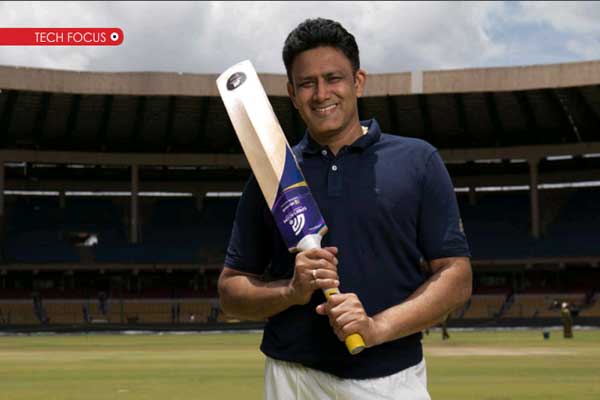In cricket we have heard a lot about the right and bad selection of shots in the commentary, depending on the speed and angle of the hit ball.
But have you ever wondered, like ballers delivered balls’ speed can be calculated what if simultaneously the batsman’s shot quality can be calculated? Subsequently taking the game to the next level of perfection on the scale of precision Well, Amid such technology influx in the game of cricket, when the game of cricket is ever evolving from its conventional mode of format, our very own former veteran Cricketer Anil Kumble has launched a software in order to measure the quality, swing, power, and twist of the bat while hitting a shot.
The former national cricket team captain and coach who also happens to be a software engineer has come up with a concept of a “power bat”-a special tool powered by the Microsoft’s Azure Cloud platform and Its Artificial Intelligence (AI) and the Internet of Things (IOT) Services. Anil Kumble who believes in changing the way game of cricket is being watched, played and learned in future, has introduced a tiny sticker, sizes around a credit card and weighing less than 5 grams. The ‘Power Bat’ carries this chip on its shoulder which in a live match as soon as Batman hit the ball, data on different parameters are captured in a new unit of measurement titled as Power Speks.
Subsequently, the data gathered out of the used sticker help to analyze the shots and break them into measurable parameters like quality (of the shots), swing (of the Bat), Power (imposed by the batman) and what was the twist there. The batman can later check out the fact whether he has hit the shot from the bat’s “sweet spot” or not.
The technology introduced by the Anil Kumble’s Start-up Spektacom technologies has already been used in the Tamil Nadu Premiere League on a limited basis and now he is thinking of taking the tech to a new level partnering with Star Sports as in broadcasting partner. The quality of the shot is measured in percentages, the speed of bat in kmph, the power in specs while the twist happens in degrees. In a live demonstration of the Power Bat at a Star Sports Studio based in Mumbai, data gathered from the bat used was shown on the screen within a few seconds.
While the broadcaster would have access to this sticker initially for their commentators to then analyze a batsman during a match, the technology would later be available commercially for anyone to buy the sticker, download the app and access their data. Kumble added that the gadget gets charged in 90 minutes and lasts for two days.
The technology advancement in sports seems never going to stop experimenting new concepts, so it’s won’t be wrong that in near future we can watch the technology enthralled action on the field which is quite remarkable both for players as well as we the viewers or audience. In addition to above-mentioned Spektacom’s Power bats, there have been plethoras of technology advancements have roped in the game of cricket. Now, LBWs did not remain an apple of discord for the umpires as UDRS has enabled batsmen as well as bowlers to ward off any suspicious on-field umpire’s decision. The International cricket council is taking all measures to increase the interest level of the audience as well as make the game of cricket more attractive in nature and mind-blowing.
Hence, since the last few years, the cricket organizers have been using many technologies advanced stuff improvises the game of cricket by including things like:
- The LED bails
Having expensive technology, LED bails are used to assist on-field Umpires in making a precise decision at the time of taking a decision like of Runouts. The bails glow as it met with a force. It retains a sensor, a microprocessor, and a low-voltage battery.
- Hawk-Eye:
It was invented in 2001 to measure the trajectory of the ball once thrown off the bowler’s hand. An optimum tool to decide the LBW in cricket, the technology is majorly used in almost every outdoor sport. The technology makes use of cameras which are aligned under the stadium roofs and create a 3D representation image of the trajectory of the ball.
- HotSpot
In the wake of wrong results by the Snickometer, HotSpot came into action. This concept of HotSpot technology makes use of the Infra-Red imagining system and shows a bright spot where the physical contact of the ball elevated the local temperature. With the use of two cameras located at the loggerhead of the ground, information is gathered based on the physical connection between ball and bat.
- Snick-o-meter
Also known as “Snicko” in the cricket dialect, the Snick-O-Meter was invented by Allan Plaskett to aid the umpires in detecting the edge and the preceding caught behind the wicket. The technology uses a microphone, placed near the stumps, to detect the sound of the hit and determine the surface of the impact. It utilizes the variation of sound frequencies of the ball while hitting different surfaces. The frequency of the sound will be different if it hits the bat or the glove, from the sound of the ball hitting the pads.
- Stump Camera
In order to provide a more in-depth experience to the viewers, the Stump cameras are utilized to closely cover the game happening in the ground. Tiny yet quite advanced set of cameras are installed inside the stumps to provide a unique angle of coverage to the viewers.
- Speed Gun
During the Joel Garner era, there was no precise equipment to calculate the pace of the bowlers. It was only in 1999 when Cricket got introduced to the concept of Speed Gun which accurately measured the speed of the ball from one end of the pitch to the other. The device relays a beam from the radar head to detect movement across the pitch.
Disclaimer:
The information contained in this article is for educational and informational purposes only and is not intended as a health advice. We would ask you to consult a qualified professional or medical expert to gain additional knowledge before you choose to consume any product or perform any exercise.






